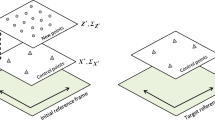Abstract
This work is concerned with refining the Helmert solutions in two different cases, namely combining different solutions and updating old solutions with newly available measurement data. The parameters to be estimated in the solutions here not only include the transformation parameters, namely the rotation, the translation and the scale, but also the coordinates in the final frame of all relevant stations. The rotations are not limited to small angles, however, the rotation estimation errors are assumed with small angles. After developing in detail the functional model and the stochastic model of either of the two cases, the parameters are estimated directly using the least-squares method, with the full variance–covariance matrix of the parameter estimates readily provided as a by-product. These variances and covariances of/between the parameters fully capture the statistical information of the final solution, which are important components of the resulting frame network besides the parameters themselves. Simulations are conducted to check the method for both the combination and update cases. It is found that in both cases, the accuracies of the transformation parameters and coordinates of some stations are improved after the combination or update. There are also some stations whose coordinate estimation accuracies remain unchanged; and it is emphasized that including these stations is also necessary in the combination and update for completely describing final frame network.










Similar content being viewed by others
References
Barfoot T, Forbes JR, Furgale PT (2011) Pose estimation using linearized rotations and quaternion algebra. Acta Astronaut 68(1):101–112
Box MJ (1971) Bias in nonlinear estimation. J R Stat Soc 33(2):171–201
Chang G (2016) Closed form least-squares solution to 3D symmetric Helmert transformation with rotational invariant covariance structure. Acta Geod Geophys 51(2):237–244. https://doi.org/10.1007/s40328-015-0123-7
Chang G, Xu T, Wang Q (2017a) Error analysis of the 3D similarity coordinate transformation. GPS Solut 21(3):963–971. https://doi.org/10.1007/s10291-016-0585-2
Chang G, Xu T, Wang Q, Liu M (2017b) Analytical solution to and error analysis of the quaternion based similarity transformation considering measurement errors in both frames. Measurement 110(1):1–10. https://doi.org/10.1016/j.measurement.2017.06.013
Chang G, Lin P, Bian H, Gao J (2018) Simultaneous Helmert transformations among multiple frames considering all relevant measurements. Meas Sci Technol 29(3):035801. https://doi.org/10.1088/1361-6501/aaa03a
Chen K, Xu T, Yang Y (2017) Robust combination of IGS analysis center GLONASS clocks. GPS Solut 21(3):1251–1263
Fang X (2014) A total least squares solution for geodetic datum transformations. Acta Geod Geophys 49(2):189–207
Fang X (2015) Weighted total least-squares with constraints: a universal formula for geodetic symmetrical transformations. J Geod 89(5):459–469
Julier SJ, Uhlmann JK (1997) Non-divergent estimation algorithm in the presence of unknown correlations. In: American control conference, Albuquerque, New Mexico, pp 2369–2373
Julier SJ, Uhlmann JK (2007) Using covariance intersection for SLAM. Robot Auton Syst 55(1):3–20
Kay SM (2013) Fundamentals of statistical signal processing, Volume I: estimation theory. Pearson Education, New York
Kotsakis C, Vatalis A, Sanso F (2014) On the importance of intra-frame and inter-frame covariances in frame transformation theory. J Geod 88(12):1187–1201
Li B, Shen Y, Li W (2012) The seamless model for three-dimensional datum transformation. Sci China Earth Sci 55(12):2099–2108
Li B, Shen Y, Zhang X, Li C, Lou L (2013) Seamless multivariate affine error-in-variables transformation and its application to map rectification. Int J Geogr Inf Sci 27(8):1572–1592
Mercan H, Akyilmaz O, Aydin C (2018) Solution of the weighted symmetric similarity transformations based on quaternions. J Geod 92(10):1113–1130
Neitzel F, Schaffrin B (2017) Adjusting a 2D Helmert transformation within a Gauss–Helmert Model with a singular dispersion matrix where BQ is of smaller rank than B. Acta Geod Geophys 52(4):479–496
Teunissen PJG (1985) The geometry of geodetic inverse linear mapping and non-linear adjustment. Publications on geodesy, new series. Netherlands Geodetic Commision, Delft, pp 1–186
Teunissen PJG (1988) The non-linear 2D symmetric Helmert transformation: an exact non-linear least-squares solution. Bull Géod 62(1):1–16
Teunissen PJG (1989a) First and second moments of nonlinear least-squares estimators. Bull Géod 63:253–262
Teunissen PJG (1989b) A note on the bias in the symmetric Helmert transformation. Festschrift Torben Krarup 58:335–342
Wang B, Li J, Liu C, Yu J (2017) Generalized total least squares prediction algorithm for universal 3D similarity transformation. Adv Space Res 59(3):815–823
Wang B, Yu J, Liu C, Li M, Zhu B (2018a) Data snooping algorithm for universal 3D similarity transformation based on generalized EIV model. Measurement 119:56–62
Wang Q, Chang G, Xu T, Zou Y (2018b) Representation of the rotation parameter estimation errors in the Helmert transformation model. Surv Rev 50(358):69–81. https://doi.org/10.1080/00396265.2016.1234806
Xu P, Grafarend EW (1996) Statistics and geometry of the eigenspectra of three-dimensional second order-rank symmetric random tensors. Geophys J Int 127:744–756
Zeng H, Yi Q, Wu Y (2016) Iterative approach of 3D datum transformation with a non-isotropic weight. Acta Geod Geophys 51(3):557–570
Zeng H, Chang G, He H, Tu Y, Sun S, Wu Y (2018a) Iterative solution of Helmert transformation based on a unit dual quaternion. Acta Geod Geophys. https://doi.org/10.1007/s40328-40018-40241-40320
Zeng H, Fang X, Chang G, Yang R (2018b) A dual quaternion algorithm of the Helmert transformation problem. Earth Planets Space 70:26
Acknowledgements
This work is supported by the National Natural Science Foundation of China (41774005, 41631072, 41474061).
Author information
Authors and Affiliations
Corresponding author
Rights and permissions
About this article
Cite this article
Li, S., Ji, B., Chang, G. et al. Helmert transformation solutions combination and update with new measurements. Acta Geod Geophys 54, 181–196 (2019). https://doi.org/10.1007/s40328-019-00249-5
Received:
Accepted:
Published:
Issue Date:
DOI: https://doi.org/10.1007/s40328-019-00249-5




